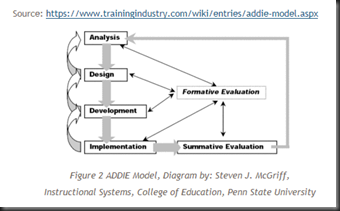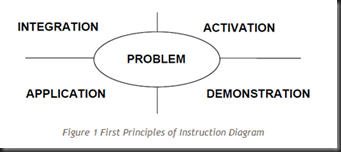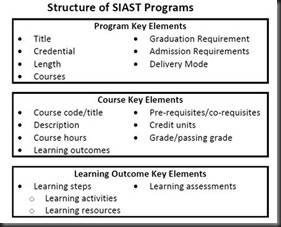1. Explore the curriculum design process
Source: http://cfmmodules.mc.duke.edu/curriculum/intro/process.html
Examine the perspective on Curriculum Development
Source: http://cfmmodules.mc.duke.edu/curriculum/intro/fullproc.html
Discuss the relevance of curriculum design to adult education
When designing curriculum for adults we should keep in mind that most adults like to practice what they have learned (experiential learning). Adults are self-directed learners. The curriculum could encourage debate, discussion and exchange of experience in the classroom.
2. Explain the curriculum design process
Curriculum design process starts by looking at the needs for the curriculum. Knowledge and technology change every day, we cannot use an 18th century curriculum to teach 21st century learners. The design should start at looking at developing rationale; clearly explain the goals for designing the process. A curriculum designer should come out with objectives for teaching and learning methods. A curriculum designer should setup evaluation strategies, which include learners, faculty and curriculum itself. This will help implement teaching and evaluation strategies. Since this is the process the curriculum should be subjected to review and if possible to be revised.
In designing the curriculum the following process has to be kept in mind:
Define curriculum terms and concepts
i. Taxonomy
Anderson and Krathwohl’s taxonomy 2001 used verbs to describe taxonomies of the cognitive domain as compared to Bloom’s taxonomy. These taxonomies are; Remembering, Understanding, Applying, Analyzing, Evaluating and Creating. See the diagram below.
Source: http://thesecondprinciple.com/teaching-essentials/beyond-bloom-cognitive-taxonomy-revised/
ii. Scaffolding
Instructional scaffolding is a learning process designed to promote a deeper level of learning. Scaffolding is the support given during the learning process which is tailored to the needs of the student with the intention of helping the student achieve his/her learning goals. Instructional scaffolding is the provision of sufficient support to promote learning when concepts and skills are being first introduced to students. These supports may include the following: resources, a compelling task, templates and guides, guidance on the development of cognitive and social skills
Source: https://en.wikipedia.org/wiki/Instructional_scaffolding
iii. Hidden curriculum
Hidden curriculum are the curriculum that are taught informally. These includes behaviours, perspectives, and attitudes. Universities and colleges have students’ policies. These are guidance to what students should obey and be good students. For example, students who are taking Paramedic course at SaskPolyTech are required to wear uniforms during training.
iv. Syllabus
when designing a curriculum, you will need to identify textbooks or topics that will be studied on that course. Some courses use more than one textbooks for references or for assignments. To create effective syllabus you need to establish course-learning outcomes. SaskPolyTech uses the term course contents as refer to syllabus.
v. Learning outcome / learning objective
Learning outcomes are measureable statements that articulate what students should know, be able to do at the end of the program.
Learning objectives articulate the knowledge and skills you want students to acquire by the end of the course.
Source: http://www.cte.cornell.edu/teaching-ideas/designing-your-course/settting-learning-outcomes.html
Identify the key elements of the instructional design process
The key elements are: Analysis, Design, Development, Implementation, and Evaluation
Outline the premises underlying the curriculum design process
Morrison et al. (2013) outline seven premises of instructional design:
i. The instructional design process requires attention to both a systematic procedure and specificity for treating details within the plan.
ii. The instructional design process starts by identifying an instructional problem.
iii. An instructional design plan is developed primarily for use by the instructional designer and planning team.
iv. While planning, every effort should be made to provide for a level of satisfactory achievement for all learners.
v. The success of the instructional product is dependent on the accuracy of the information of flowing into the instructional design process.
vi. The instructional design process focuses on the individual rather than on the content.
vii. There is no single best way to design instruction
Outline the roles of those involved in program design
i. Instructional Designer
1. plan and carry out the planning process
2. competent in managing the ID process
3. primary responsibility is the designing for instruction
ii. Subject matter expert (SME)
1. qualified to provide information about content and resources relating to all aspects of topics for which instruction is to be defined
2. check accuracy of content
iii. Evaluator
1. person who assists in developing instruments for pretesting and evaluating student learning and interpreting resultant data
2. determines effectiveness and efficiency of program once it is implemented
3. Conduct a needs assessment
Describe the types of needs and data sources included in a needs assessment.
Six identifiable categories of needs are used for planning and conducting a needs assessment (Refer page 31 from the textbook - Designing effective instruction).
i. Normative Needs.
The national achievement test such as Scholastic Aptitude Test (SAT) are typical example of Normative need. Students are tested against a national standard. In public schools, students are normally tested in Math and each school is compared to the existing national standard.
ii. Comparative needs
Comparative needs is similar to normative needs, the only deference is that the comparison is only done between one group to another rather than norm.
iii. Felt Needs
Felt needs are necessary needs as felt necessary for the learners. Let say for example two campuses are teaching automobile technology. If one campus is lacking a certain technology and students are not at the same level as the other company, then there will be a need to train instructors so that they are on the same level as the other campus.
iv. Expressed Needs
When people are put on the waitlist, waiting to attend a course or program, then they are on expressed needs. It is a felt needs that is put into action.
v. Anticipated or future Needs
Anticipated needs are a means of identifying changes that will occur in the future. For example, SaskPolyTech is working on Academic model, which is good example of the future needs.
vi. Critical Incident Needs
Chemical spill, earthquake and shooting in schools are typical example of anticipated disaster or incident that can happen. The students and employee are trained and prepared in case there will be a future incident like these.
Discuss phases contained within the needs assessment process.
Four phases constitute needs assessment are: planning, collecting data, analyzing data, and preparing the final report. Planning involve defining the audience and develop the strategies. Kind of survey to the audience is conducted and then analyzed. Collecting data involve determining the size of data to be collected. Plan the scheduling carefully to individuals who will participate in collecting the data. Once the data is collected then it will analyzed and help lead to a prioritization of needs. Finally the report is to be finalized. The final report will include summary of the study’s purpose, summary of the process, summary of the results and necessary recommendation.
Conduct a learner analysis.
When planning for instruction, factors such as; learner’s personal and social characteristics, learners learning styles, learners’ cultural diversity, adult learners and also learners with disabilities should be considered. Adult learners have past experience and instruction should avoid repetition of the hands-on activities if learners do not need to. Instruction designers should also consider people with disabilities and design activities that can be accessed by them.
Conduct a context analysis.
The common tools for conducting a contextual analysis include surveys, observations, and interviews. There are three types of contextual analysis that an instructional designer should analyze when designing instruction:
i. Orienting Context
Analysis can be done to the learner’s knowledge, skills, and attitude that he/she brings to the instruction. Instructor’s designer should find it out what is the learners’ goals for attending the course.
ii. Instructional context
classroom environment, teaching tools, and other simple teaching strategies are important to the learners and instructor designer should conduct a contextual analysis.
iii. Transfer context
Instructional designer should also do analysis and evaluate if the skills will be transferable after the course or program.
4. Discuss instructional /curriculum design models commonly applied in adult educational environments
Here are various instructional design models that are applied to adult education
Merrill's First Principles of Instruction

Describe ADDIE Model of Instructional Design
Involve Analysis, Design, Development, Implementation, and Evaluation. These processes represent a dynamic, flexible guideline for building effective training and performance support tools.
Dick and Carey Model
According to Dick and Carey, "Components such as the instructor, learners, materials, instructional activities, delivery system, and learning and performance environments interact with each other and work together to bring about the desired student learning outcomes".
Source: http://www.instructionaldesigncentral.com/htm/IDC_instructionaldesignmodels.htm
Review the Saskatchewan Polytechnic curriculum model
Saskatchewan Polytechnic instructional design model is similar to the ADDIE model. The phases in the Saskatchewan Polytechnic model are Analysis, Design, Development, Delivery, and Evaluation.
Describe Tylerian curriculum model:
This model was developed by Ralph Tyler to simplify the curriculum development process. Consists of four primary steps…
I. Development of performance objectives
II. Development of activities
III. Organization of activities
IV. Evaluation
5. Develop an Instructional plan
Example: To develop a Physics instruction Jeopardy game using Power Point or Dreamweaver:
There are six structures often associated with a task analysis
i. Facts – Example of facts in physics will be symbols, definitions, formula etc.
ii. Concepts – Using jeopardy game to involve students in their learning.
iii. Principles and rules – Have two groups of students competing each other by answering correct answers. The Instructor will be a judge to determine if the answer is close enough to get 100% mark.
iv. Procedures - Groups will be timed for 1 min to answer the question.
v. Interpersonal skills – Instructor should have good skills on using Power Point or Dreamweaver programs
vi. Attitudes – Student involvement and their discipline in the classroom.
Write Learning outcomes:
Example: Assess the effects of radioactivity and nuclear technology on society and the environment
Source: Saskatchewan Physics 30 curriculum
6. Design the instruction
Choose appropriate instructional strategies
Example: Using Power Points, you can design a Jeopardy Game that will involve all students. This way students can learn facts, concepts, and rules about the topic the instructor is intend to teach. Students will also learn interpersonal skills such as working as a team and attitudes. By the end of the game students will have mastered most of the concepts and the instruction will be meaningful. Different instructional strategies should be used to different types of instruction. For example, laboratory works for science and trade courses.
a. Develop an evaluation plan
For the Jeopardy Game; students are rewarded points for each correct answer, as part of evaluation. The purpose of evaluation is to get the instructor interprets the assessment information and make a professional judgement about the student’s progress. Assessment can be a summative assessment or formative assessment. Instructors should plan evaluation according to the curriculum. For example, students who are learning math, evaluation should be on their math activities. The evaluation methods may include class assignments or home works, quizzes, tests, exams and projects. Instructors may also do assessment for learning to determine where the gaps are and help students on the individual bases. Assessment for learning is about gathering student’s data on their continuous learning and determine which area the student need to improve in order to move forward.
7. Outline the relationship between curriculum orientations and program design.
The following steps or procedures for developing curriculum are identifying the problem, determining if the training is required, completing a learner and contextual analysis, designing the instruction and evaluation methods.
Define the curriculum orientations of transmission, transaction and transformation
i. Transmission:
In transmission orientation, the function of the education is about teaching facts, skill and values. The curriculum is based on mastery of traditional subjects especially is using textbooks for learning. This is a mechanistic view of human behavior whereby skills are developed through specific instructional strategies. The skills are conveyed in a one-way process.
ii. Transaction:
In transaction orientation, the curriculum assumes that the students are capable of problem solving and that the students reconstruct knowledge through dialogue. The curriculum is based on constructivism method and that the curriculum facilitate problem solving.
iii. Transformation:
Transformation focusses on personal and social change. The curriculum should promote personal and social transformation (humanistic change orientations). The role of the instructor is to link cognitive skills with the aesthetic, emotional and spiritual dimension life and link with the community. Evaluation of the students can be informal and may include conventional modes that focuses on skill and subject mastery. The transformation orientation is the most complex orientation. It involves attitudinal change due to direct experience. This orientation provides the opportunity for important learning, but may be a difficult orientation for both instructor and student.
Determine influence of curriculum orientations and program design
| Transmission | Transaction | Transformation | |
| Role of the Instructor | · Directive · Uses informative method | Facilitator | · Link cognitive skills with the aesthetic, emotional and spiritual dimensions of life · Link with community |
| Evaluation | · Achievement test · Summative evaluation | · Problem solving and social skills · Formative evaluation | · may include conventional modes that focus on skill and subject mastery · informal and experimental forms of evaluation |
Source: http://faculty.nipissingu.ca/johnlo/thinklikeateacher/curriculum_orientations.htm
8. Plan for Instructional Implementation
The implementation strategy mean that the target audience will get the message and be able to use the product that is created.
Examine the CLER (Configurations, Linkages, Environment and Resources) model of curriculum implementation.
The following is a brief outline of the CLER elements according to Morrison et. al. (2007).
i. Configuration
network of various social units and individuals who play a variety of formal & informal roles
- four types of units: individual, groups, institutions, cultures
ii. Linkages
networks or relationships between designer and client
- formal linkages
- informal linkage
iii. Environment
physical, social, intellectual forces operating in configuration
iv. Resources
- Conceptual. Example technical skills such as need of computers, software, and internet etc.
- Influence. Such as incentives, goodwill, brand names etc.
- Material. Money backing, computers, projector, DVD etc.
- Personnel. Manpower
- Institutional. Personnel infrastructure, internet or intranet, tables, desks etc.
- Time. Plan well to avoid poor outcomes.
Describe the decision to be made during instructional implementation.
Refer Morrison et al. Chapter 15 (pp. 388)
i. Successful implementation of the final product will depend on merits, compatibility, complexity, and visibility as perceived by the client system and on their ability to try it.
ii. The instructional designer is responsible for program promotion. After the course has been implemented the instructional designer may request kind of feedback how the course has contributed toward organizational goal.
iii. Course logistics and the delivery of the instruction should consider classroom facilities, media equipment and other equipment, transportation, housing, and food.
iv. Material required for instructional implementation have to be decided. The Instructional designer is responsible for packaging, duplication and shipping.
v. The last decision, concerns the instructors. The two issues of concern are the scheduling and training. Carefully planning is required to schedule the time. Scheduling a course requires consideration of the workload to minimize the impact on the productivity. Instructors training is vital important to improve instructors’ teaching and presentation skills. That is why SaskPolyTech has New Instructors’ orientation (NIO) workshop and Faculty Certificate Program (FCP).




